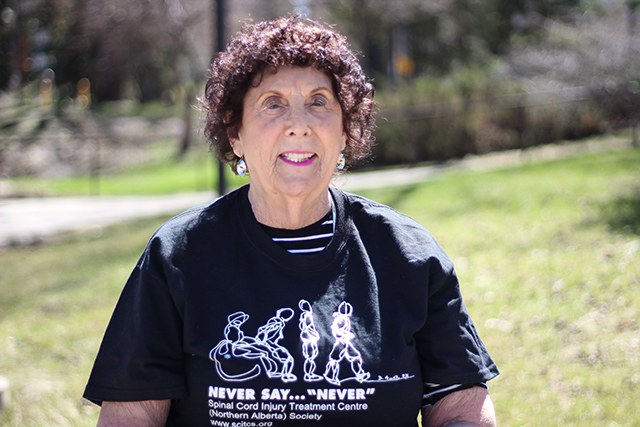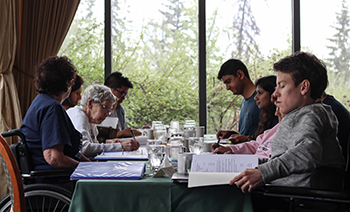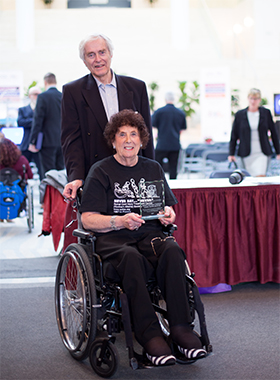
Louise Miller, leader and founder of SCITCS, wears a t-shirt with their slogan "Never say never." (Photo: Melissa Fabrizio)
Louise Miller is the leading founder, president and spokesperson of the Spinal Cord Injury Treatment Centre Society (SCITCS), a not-for-profit organization dedicated to finding solutions and better quality of life for people with spinal cord injury. Her persistent work with SCITCS began three decades ago.
Louise and her husband John arrived in Edmonton in the 1960s from the U.K. and Louise worked as a nurse while also developing a career in the fields of education and business. In the late 1980s, a life threatening virus changed the course of Louise Miller's life. After she developed myocarditis, an inflammation of the heart, she had to undergo surgery with a very low chance of survival; her surgery was successful, but a spinal cord injury was the side result.
"Of course, as soon as you can't walk that's the first thing you want to do," Miller said. From that moment onwards, she and her husband John embarked on a resolute journey together to help people with spinal cord injuries to "never say never."
Aside from its many projects-many of which include close ties with U of A researchers-this year SCITCS was honoured with the City of Edmonton Mayor's Award for outstanding service, presented to organizations in Edmonton with deep commitment to people with disabilities. Although this isn't the first time SCITCS received a Mayor's Award, being recognized in 2017, the 30th anniversary year for the organization, makes the milestone that much more meaningful for the Millers.
The birth of SCITCS: Searching for solutions
After Miller's surgery, she spent months in rehabilitation at the hospital, and the couple began exploring novel therapies and devices that could provide Louise a chance to walk again. They quickly realized that the devices and braces available at the time were not very practical for daily use and had difficulty mimicking the natural movements of the limbs.
While still in hospital, Miller was elected to the board of the Canadian Paraplegic Association (now Spinal Cord Injury Alberta). She connected with researchers from all over the globe to learn more about their early breakthroughs in areas like functional electrical stimulation (FES) and helped bring some of their innovative equipment to Canada and to the city of Edmonton.
A fateful dinner after a research day event led her to connect with University of Alberta's Richard Stein in 1987-a meeting that would eventually lead to the birth of SCITCS.
"I'm sitting with the researchers, and I don't know anybody. Nobody is talking to me. All these guys are talking together about everything they do and I'm getting more annoyed by the minute," said Miller. "So I said, 'Excuse me,' and I told them that, and I said, 'How come we don't know about all this that you're doing?'"
Stein, from the Department of Physiology and the Centre for Neuroscience, coordinated a follow-up meeting to share more with her about the research projects. "I told him, 'I will be in your office on Monday morning and I want to hear it.' Monday morning, I am there. And he had this big guy with him called Dr. Dejan Popovic," she continued.
Popovic, a European researcher, had developed handheld devices for people with spinal cord injury, which could help them stand from their wheelchairs and take steps using electrodes attached to the skin of their legs. "We became friends. After that I used to tease him every time I told the story about how Dr. Stein brought reinforcements to the meeting," she remembered with a laugh.
Community members quickly took notice of the work of the Millers. The couple was approached by other people affected by spinal cord injuries who were interested in raising funds for the cause. "We borrowed money from volunteers, we bought t-shirts, sweatshirts, pants. We sold them, gave the money back, borrowed back again, and did the same thing," said Miller.
Soon after, they formally registered as a non-profit organization. A small group of volunteers marked the beginning of SCITCS 30 years ago, including former Edmonton Oilers player Craig Simpson-who remains as Honorary President of the organization- and attorney Anton Melnyk, who still provides pro bono legal advice to SCITCS.
Donations from the Jasper Place Legion provided initial funding to buy five of Popovic's handheld devices. From there, under Stein and Popovic's lead, the SCITCS Project Walk, an intensive exercise program for people with spinal cord injuries, was established.
SCITCS today
Thirty years later, Louise Miller enjoys a sunny afternoon at the Faculty Club-her favourite meeting spot-and has lunch with her husband, while she reflects on the three decades of their work. Miller is well known throughout Edmonton and the U of A as an engaged alumna and community builder, for her work as a 2001 class organizer, recognized in 2013 with a Doctor of Law honorary degree and for her leadership of SCITCS.
Since its creation, SCITCS has not hired any staff; it operates only through the help of volunteers. Miller's work focuses on opportunities to improve quality of life; she explains that people with spinal cord injuries are not most desperate to walk again. "It's to feed themselves, go to the washroom by themselves, being able to scratch themselves."

There are strong links between the U of A and SCITCS. The most recent example is the organization's ongoing collaboration with the Sensory Motor Adaptive Rehabilitation Technology Network (SMART Network)-a group of more than 90 U of A researchers developing wearable devices, artificial limbs and implanted microdevices to improve quality of life for people with neural injuries and diseases. Both Louise Miller and SMART Network director Vivian Mushahwar describe the match as "a marriage made in heaven."
The partnership took root with Miller's concern about people with spinal cord injuries, such as Christopher Reeve, who had died in 2004 due to the complications of pressure ulcers.
"I came to campus and I said, 'We're going to talk about pressure sores.' This is what I do, I call a meeting. My theory is that people come because they want to know what I'm up to now, and how that's going to impact them," said Miller, laughing. Stein soon referred Miller to Mushahwar and the teams of U of A researchers working on ways to prevent pressure ulcers.
"SCITCS was instrumental in providing us with the seed funding that allowed us to start working on our idea," said Mushahwar. "This FES system that would prevent pressure ulcers from forming is what became Smart-e-Pants, bionic underwear that prevents bedsores. Many years later SCITCS is meeting their ultimate goal of improving the lives and the function of people with spinal cord injury."
The latest contributions of SCITCS helped make possible the academic appointment of Chester Ho, new Spinal Cord Injury Research Chair and Director of the Division of Physical Medicine & Rehabilitation in the Department of Medicine.
The 'gentle tenacity' moving a dream forward

John and Louise Miller received the Mayor's Award for Outstanding Service. (Photo: City of Edmonton)
Throughout the years, the Millers have gained allies and friends. Although they are quick to point out that SCITCS has advanced thanks to numerous dedicated volunteers, many trace the organization's longtime success back to the Millers' commitment and, particularly, to Louise Miller's dogged determination.
"Louise, John and SCITCS in general have a gentle tenacity," said Martin Ferguson-Pell, current vice-principal of the U of A's Peter Lougheed Leadership College, biomedical engineer in the Faculty of Rehabilitation Medicine and also a member of the SMART network. "They have a clear idea of what's needed and consult widely with different groups―people with disabilities, researchers and clinicians involved in the field of spinal cord injury. They never let go, but they do it in a very gentle and collegial way."
Mushahwar, who has cultivated a friendship with the Millers, says they are humble people that are deeply committed to improving people's lives. "The Millers really look at the continuum of care, from when people are first injured and come to the ICU. And they communicate with the people upfront, early on. They help them out in managing their new life situation, because a spinal cord injury is something that just alters a life in a second."
"The slogan Louise has used for SCITCS, 'never say never,' really exemplifies her style-no matter how difficult the task, she always finds a way around it, under it or over it, and makes things happen when other people wouldn't have been able to do so," said Stein. "It really has been the lifetime work of Louise Miller and she's shown an amazing ability to focus on what really matters in terms of improving the lives of people with spinal cord injury."